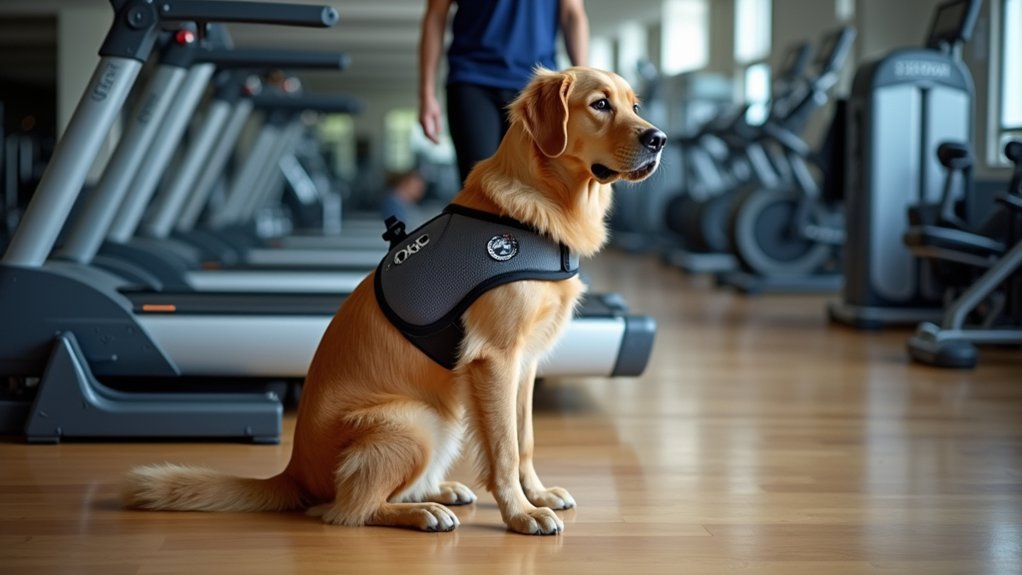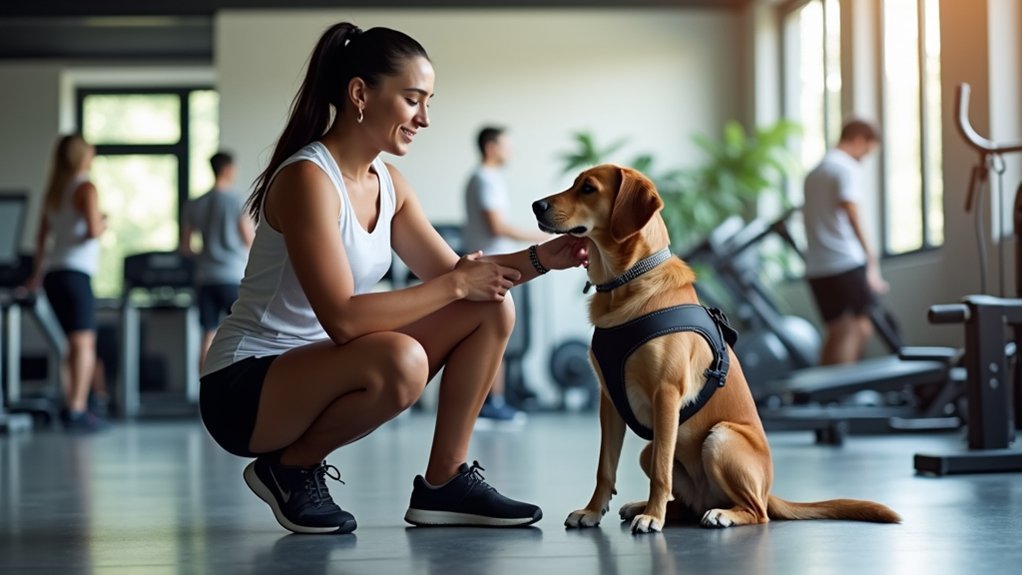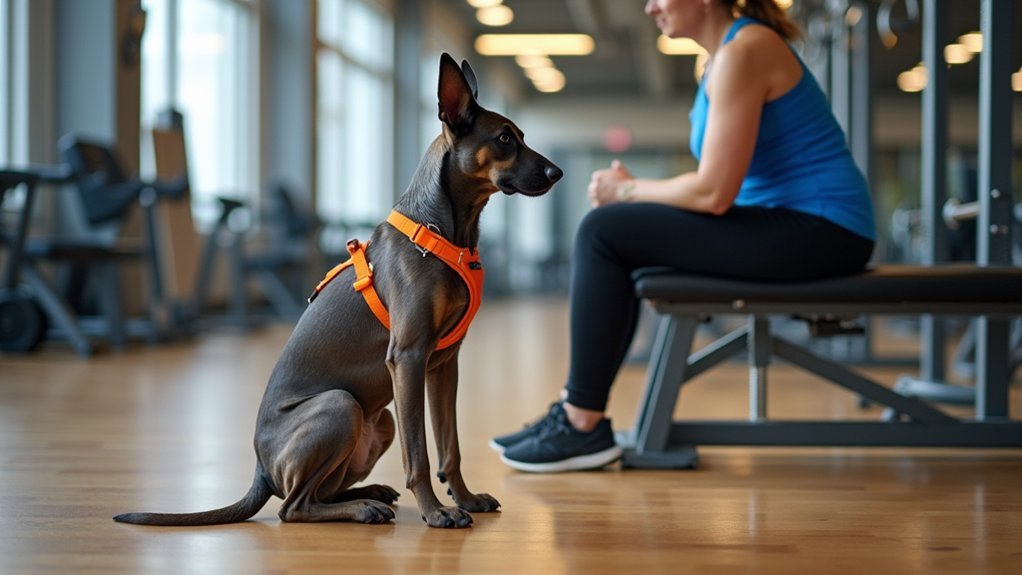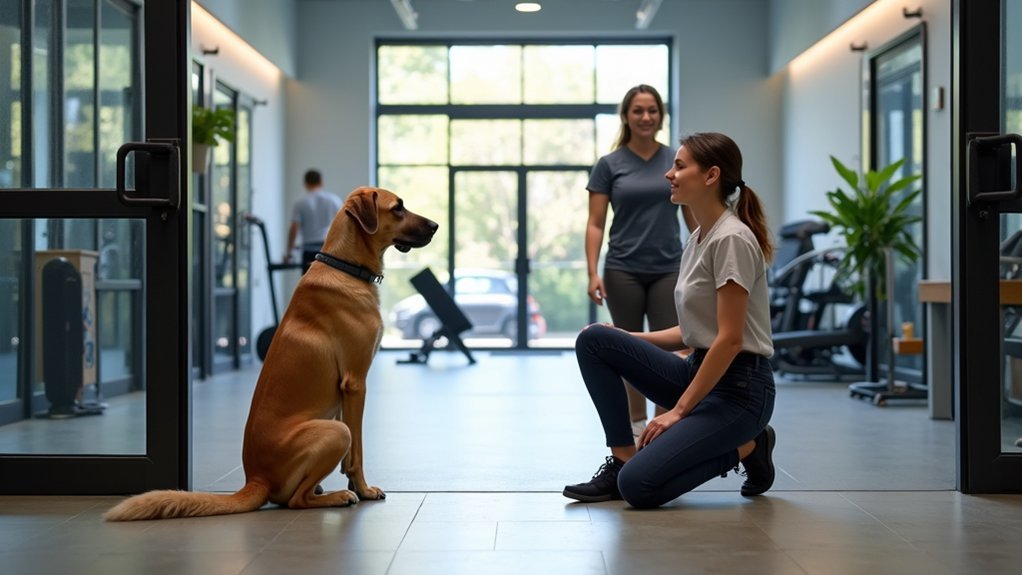When you bring a guide dog into a gym, you’re maneuvering more than just workout equipment—you’re entering a complex environment with unique challenges. Service animals require specialized considerations that go beyond typical pet interactions. Understanding the intricate balance between maintaining your fitness routine and ensuring your guide dog’s safety demands careful preparation and awareness. Are you ready to explore the essential protocols that can transform your gym experience from potentially stressful to seamlessly inclusive?
Key Takeaways
- Service dogs are legally protected under the ADA and must be allowed in gym facilities without additional fees or unnecessary restrictions.
- Gym staff should maintain clear pathways, minimize distractions, and avoid unauthorized interactions with guide dogs to ensure the handler’s safety and mobility.
- Handlers are responsible for monitoring their guide dog’s behavior, maintaining focus, and ensuring the dog remains calm in a busy gym environment.
- Establish clear communication protocols for emergency situations, including specific evacuation procedures that prioritize the safety of both the guide dog and handler.
- Implement comprehensive hygiene practices, such as regular equipment disinfection and designated relief areas, to create a safe and inclusive gym atmosphere for all members.
Understanding Service Animal Legal Protections

Because service animals play a critical role in supporting individuals with disabilities, understanding their legal protections is essential for gym owners and patrons alike. Under the Americans with Disabilities Act, service dogs are specifically defined as trained canines assisting handlers with disabilities, ensuring their access to public places like gyms. These guide dogs are distinguished from emotional support animals by their specialized training in performing specific tasks that directly mitigate their handler’s disability. Gym staff must adhere to strict legal protocols, including permitting service dogs without additional fees and restricting inquiries to two key questions about the animal’s service status and trained tasks. Safety protocols and respectful etiquette demand recognizing these animals as critical accessibility tools, not mere pets.
Navigating Equipment and Exercise Space

In three critical steps, gym patrons and staff can effectively accommodate guide dogs while maintaining a safe, accessible exercise environment.
- Keep Paths Clear: Organize equipment meticulously, ensuring the guide dog and handler can navigate exercise areas without encountering unexpected obstacles or cluttered spaces.
- Maintain Distance: Provide ample space around the handler and guide dog, minimizing potential distractions that could compromise the dog’s focus and safety.
- Manage Environment: Reduce loud noises and sudden equipment movements that might startle the guide dog, creating a calm, predictable workout atmosphere.
- Communicate Proactively: Engage with the handler about equipment locations and potential navigation challenges, demonstrating respect and supporting smooth movement through the gym’s layout.
These strategies prioritize the guide dog’s critical role in ensuring the handler’s independent mobility and exercise experience.
Handler Responsibilities and Dog Training

As gym environments present unique challenges for guide dogs, handlers play an essential role in ensuring successful navigation and performance. You’ll need to prioritize thorough dog training that prepares your guide dog for diverse gym environments, focusing on maintaining concentration amid potential distractions.
Your handler responsibilities extend beyond basic commands. You must consistently monitor your dog’s safety and well-being, ensuring they remain focused and calm. Implement training protocols that expose your service animal to various sounds, movements, and equipment configurations. Effective communication through precise commands is vital, preventing confusion and maintaining your dog’s professional performance.
Preventing Potential Safety Hazards

When traversing gym environments, guide dog teams must proactively address potential safety hazards to guarantee seamless and secure movement. Consider these critical safety protocols:
- Ensure clear pathways by strategically positioning gym equipment to prevent obstructions that could impede the guide dog’s navigation.
- Establish designated quiet rest areas for the guide dog, minimizing exposure to high-traffic zones and potential distractions.
- Implement thorough staff and member training on guide dog etiquette, emphasizing the importance of not interrupting the working dog’s concentration.
- Develop and enforce strict gym policies prohibiting unauthorized interactions with guide dogs and preventing potential conflicts with other animals.
Communication Strategies With Staff and Members

Effective communication forms the cornerstone of successfully integrating guide dogs into gym environments, requiring a strategic approach that prioritizes respect, education, and understanding. Gym staff must be thoroughly trained on ADA guidelines regarding service animals, learning to ask only permissible questions about the dog’s specific work and disability-related assistance. Your communication should focus on creating awareness among members about proper etiquette around guide dogs, emphasizing the critical importance of avoiding distractions and maintaining a safe distance. Clear, respectful communication guarantees the handler and service animal can navigate the gym environment without interruption. By implementing consistent training sessions and promoting open dialogue, you’ll cultivate a supportive atmosphere that recognizes the essential role of guide dogs in maintaining independence and mobility for individuals with disabilities.
Maintaining Proper Hygiene and Cleanliness
Three key principles drive hygienic practices when integrating guide dogs into gym environments: cleanliness, safety, and respect for both human and canine health. Maintaining proper hygiene requires diligent maintenance and thoughtful safety protocols.
- Disinfect gym equipment regularly to minimize germ transmission, using non-toxic cleaning products safe for guide dogs.
- Establish designated relief areas that are easily accessible and quickly cleaned to prevent contamination.
- Encourage gym-goers to wash hands after interacting with guide dogs to reduce bacterial spread.
- Implement thorough cleaning procedures that protect the health of humans and service animals.
These practices promote a clean, safe environment where guide dogs can effectively support their handlers while maintaining exceptional hygiene standards. Proactive cleanliness demonstrates respect for service animals and creates a welcoming gym atmosphere.
Managing Potential Distractions During Workouts
Because guide dogs play a critical role in supporting individuals with visual impairments during fitness activities, managing potential distractions becomes paramount for ensuring their safety and performance. Gym-goers must understand that a guide dog’s focus is essential to its handler’s safety. You’ll want to maintain a respectful distance and avoid sudden movements or loud noises that could disrupt the dog’s concentration.
Never attempt to pet or call out to a guide dog while it’s in harness, as this undermines its critical responsibilities. The gym environment requires strict protocols to minimize potential distractions. Staff and patrons should be trained to recognize the importance of creating a calm, controlled space that allows the guide dog to remain attentive and effectively support its handler’s workout routine.
Creating an Inclusive Fitness Environment
When fitness centers prioritize accessibility, they transform into welcoming spaces for all individuals, including those with visual impairments and their guide dogs. Creating an inclusive fitness environment requires deliberate strategies:
Fitness centers become truly welcoming when they intentionally design inclusive spaces that support individuals with visual impairments and their guide dogs.
- Implement thorough staff training on ADA regulations and guide dog etiquette
- Post clear signage prohibiting distractions like petting or interfering with working dogs
- Design facility layouts ensuring full access for guide dog handlers
- Establish supportive protocols that protect the safety and working status of guide dogs
These approaches demonstrate a commitment to an inclusive environment where guide dogs can seamlessly accompany their handlers during fitness activities. By focusing on understanding, respect, and proactive support, fitness facilities can create spaces that welcome all individuals, regardless of visual ability, while maintaining a professional and considerate atmosphere for every patron.
Emergency Protocols and Accommodation Procedures
Building upon the principles of inclusivity established in facility design, effective emergency protocols become a critical component of extensive guide dog accommodation. Health clubs must develop thorough evacuation procedures that prioritize the safety of the dog and handler. When emergencies arise, staff should immediately recognize that service dogs must remain with their handlers, guaranteeing guide dog teams aren’t separated during critical moments.
You’ll want to guarantee clear communication about exits, potential hazards, and specific assistance needs. Staff training is essential—they must understand ADA regulations and be prepared to assist handlers quickly and professionally. Your gym’s emergency protocols should specifically address the unique requirements of individuals with guide dogs, demonstrating a commitment to extensive safety and inclusivity.
Frequently Asked Questions
What Is the Etiquette for Guide and Service Dogs?
You shouldn’t distract service dogs in public spaces, respect their training, and always seek owner permission before interaction. Maintain awareness of the dog’s working status and prioritize their critical accessibility role.
Are Service Dogs Allowed in Gyms?
Yes, service dogs are allowed in gyms under ADA regulations. They must be trained to assist individuals with disabilities, follow service animal rights, and can access public fitness environments without additional membership restrictions.
What Not to Do With a Guide Dog?
Don’t distract a guide dog with petting, noise, or food. Respect its personal space, avoid leash handling, and never interfere with its training signals. Maintain environment awareness and prevent unexpected encounters that could compromise the dog’s critical working focus.
What Are Three Behaviours That a Service Dog Should Not Do in Public?
Like a conductor guiding an orchestra, a service dog must maintain perfect discipline. You can’t let your dog display distraction, engage in inappropriate barking, or demonstrate aggressive behavior in public spaces, which compromises its professional working role.
Do Guide Dogs Have to Wear a Vest?
You’re not legally required to have a vest for your guide dog. While vest designs can enhance public perception, the dog’s training standards and task performance matter most, not visibility accessories.
Conclusion
You’ve learned that guide dogs are more than companions—they’re lifelines in fitness spaces. By understanding legal protections, practicing proper etiquette, and fostering mutual respect, you’ll transform gyms into inclusive environments. Like a trusty carrier pigeon delivering critical information, these remarkable service animals navigate complex workout landscapes, ensuring their handlers can pursue fitness goals with confidence and independence.
